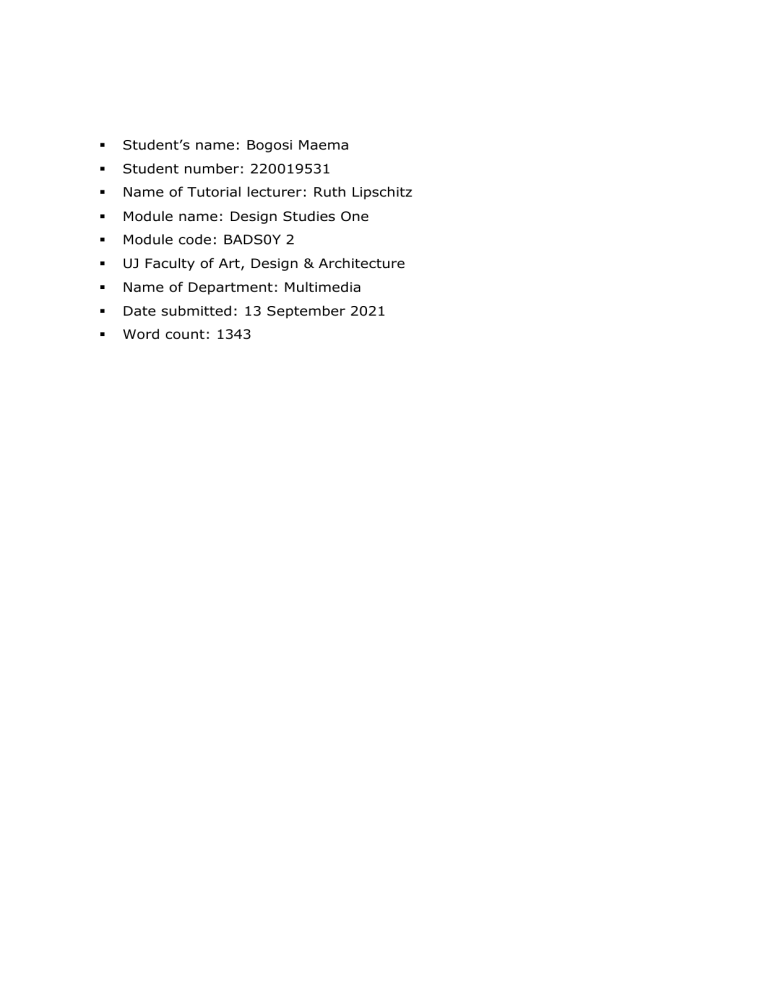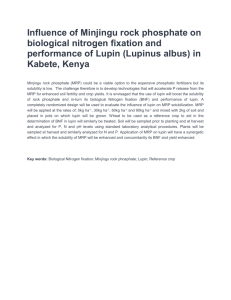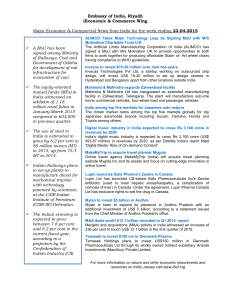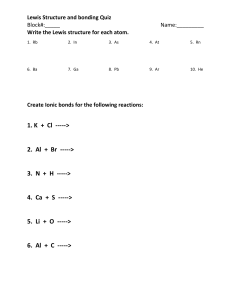
Student’s name: Bogosi Maema Student number: 220019531 Name of Tutorial lecturer: Ruth Lipschitz Module name: Design Studies One Module code: BADS0Y 2 UJ Faculty of Art, Design & Architecture Name of Department: Multimedia Date submitted: 13 September 2021 Word count: 1343 TABLE OF CONTENTS LIST OF FIGURES ESSAY SOURCES CONSULTED ANTI PLAGIARISM DOCUMENT i ii iii ix xi FIGURE 1 ii LIST OF FIGURES Designer unknown, Lupin (2009) viii In this essay I will be providing a definition of afrofuturism, I will do this through the use of supporting information from the prescribed readings I have received this term such as Jone Johnson Lewis’ texts on the topic. Although I aim to mainly discuss and define the aims as well as objectives of afrofuturism I will also be using the popular new fictional television series Lupin to highlight some of the issues that correlate to the topic of afrofuturism. I will be focusing on the imagination of counter futures specifically in the aspect of social ideas relative to the Lupin fictional series rather than technology, myth forms or the other aspects of afrofuturism. Afrofuturism is a concept that is deep-rooted mainly in the film genre of science fiction, it touches on issues relative to the identity of blacks when topics such as technology, mythology and liberation from their oppressive dictators. The concept in its entirety seeks to empower as well as strengthen the black community/identity in regards to the fact that they have been deprived access to resources such as technology as well as opportunities to advance socially or academically due to exploitation and violence from their oppressors. Jone Johnson Lewis (2018:[sp]) states at this point that “afrofuturism can be seen as a reaction to the dominance of white, European expression and a reaction to the use of science and technology to justify racism and white or Western dominance and normativity”. The concept describes a certain set of ideas that attempt to address past oppression of the black community, in the present through creation of art and media that entail a different future or rather different possibilities in the future for the black community. The concept attempts to reimagines or move past the issues that arose due to European slavery and the amount of death as well as bloodshed that occurred through the trans-Atlantic slave trade. The series I have chosen as an example of afrofuturism does a great job of reimagining a future or an alternate present for the black identity through its main character Assane Diop aka Lupin. Throughout Assane/Lupin’s youth growing up in a racist colonial France the series shows Lupin when he is a grown man and is exacting his own form of justice towards the aristocrats that discriminate towards the black identity. Yet they contrast that part of his life to the events that happened surrounding his youth in such a colonial and oppressive time. The main character Lupin is an excellent example of a iii representative of the black identity/community who refuses to be barred or defined by the standards of the West as well as their racial prejudices. Although the afro in afrofuturism is meant to be a representation of African ideas, aesthetics, ideals, social structures and culture, the term afrofuturism in its entirety is an African American concept, it is not one created or particularly embraced by people in the African continent. Most of the stories encompassing afrofuturism are usually accompanied by an experience of slavery and colonization from an African American stand point as compared to an African perspective or in the case of Lupin, a French perspective of slavery. This is one of the distinctions between Lupin and more classic/standardized tales of African American afrofuturism, Lupin focuses on a more realistic historical portrayal and counter future imagination rather than the general American version of the concept. Where traditional afrofuturism strives to create a false sense of universalism according to Louis Chude-Sokei (in Steinskog 2018:16), between all kinds of Africans throughout the world, the show Lupin strives solely to create a more realistic realism for the black identity in a post-colonial france rather than striving to unify the entire diaspora through one historical perspective. Jone Lewis (2018:[sp]) mentions that “The literary realm of magic realism overlaps often with afrofuturist art and literature. Afrofuturism is grounded in a variety of inspirations such as black cyberculture”, what I appreciate about Lupin is that although it falls under the genre of afrofuturism it doesn’t focus too much on using the imagination to create “a separation of time and space from current reality” Lewis (2018:[sp]). Lupin focuses on using imagination to give a fictional twist to current reality rather than imagining a whole new reality, it focuses on the possibility for the black French identity to fight back against colonial conquest but with current technology as well as means instead of futuristic/ sci fi means. Silvia Bombardini (2016) states that “afrofuturism as a school of thought seeks to liberate the present from the past, by crafting astral visions of alternate black futures”. The alternate black future in Lupin is one where a young boy who grew up under oppression from Europeans and had his family constantly fighting against the societal pressures of a racist community. Eventually the boy grows iv up to be a high end thief that specializes in stealing valuable gems from the aristocrat society, the plot of Lupin to me is a perfect example of the “astral visions” Bombardini (2016) was referring to. Following this connection between my example and Silvia Bombardini’s words I can undoubtedly corroborate those two representations of an element of afrofuturism to Jone Lewis’ (2018:[sp]) statement when she mentions that “art is used to imagine counter futures free of Western dominance, but also as a tool to implicitly critique the status quo”. Lupin is a piece of art that uses a black main character to symbolize the image of a black identity actively taking revenge towards it’s dictators for a history of oppression and the television series does this excellently through Lupin’s theft of the jewels that are worth millions in euros. The jewels themselves could serve as another symbol in the series that seeks to address the blood African slaves have spilled to obtain those luxurious jewels. Lupin stealing these jewels from the rich white aristocrats could serve as a sort of symbolism in the television series of the black community taking back the wealth that was once theirs and as Lewis (2018:[sp]) said “critique the status quo”. Although Lewis (2018:[sp]) mentions that afrofuturism aims to use the counter futures it creates through imagination in order to display a historical reconstruction of the past of the black identity, in Lupin Assane Diop’s history in a racially oppressed France is the specific historical recreation that takes place in my example. Lewis (2018:[sp]) concludes this statement when she states that the counter futures that are envisioned are “not only to envision the future but to affect it, is the core of the afrofuturist project”, where the fictional film of Lupin showcases this precisely is in elements such as Assane’s ability to fight colonial laws and aristocrats by himself. Assane’s ability to do this serves as a symbolic reference of the (French) black identity or as a symbolic reference of the diaspora’s power and ability to defy the Eurocentric standards that govern our ‘modern’ world. Where Lewis (2018:[sp]) continues to state that there were certain technologies or barriers that were put in place in order to impose oppressive laws upon black people globally, these technologies include but are not limited to money and language. The show Lupin expands on the point that Lewis is making because there are countless instances in the show where the unequal status quo is prevalent and is used as a tool or a technology to lord over v everybody who is considered inferior. Brandon Sutton (2019:[sp]) mentions that “Afrofuturism seeks to reweave and disrupt dominant narratives regarding the relationship between race and technology”, in Lupin the character Assane Diop is a symbolic reference of a representation of black identity that disrupts dominant or standardized narratives of race and is thus a suitable portrayal of the concept of afrofuturism as a whole. In conclusion afrofuturism is a concept that is deep-rooted mainly in the film genre of science fiction but the show Lupin strives solely to create a more realistic realism for the black identity in a post-colonial france rather than striving to unify the entire diaspora through one historical perspective. vi FIGURE 1 Designer unknown, Lupin (Lupin 2021) vii SOURCE LIST Bombardini, S. 2016. Afrofuturism. Modern Weekly, China [O] Available https://www.academia.edu/31014366/Afrofuturism Accessed 12 September 2021 Johnson Lewis, Jone. 2018. Afrofuturism: Imagining an Afrocentric future. Rejecting Eurocentric dominance and normalization. ThoughtCo. [O] Available: https://www.thoughtco.com/afrofuturism-definition-4137845 Accessed 27 July 2019. Lupin. 2021. [O]. Available: https://netflix.fandom.com/wiki/Part_1_(Lupin) Accessed 12 September 2021 Sutton, Brandon. 2019. Shadows cast by imaginary worlds: Afro Past, Present, and Future Isms. The Culture Crush [O] Available https://www.theculturecrush.com/shadows-cast-by-imaginary-worlds 12 September 202110 September 2019. Steinskog, E. 2018. Afrofuturism and Black Sound Studies: Culture, Technology, and Things to Come. London: Palgrave MacMillan. viii APPENDIX B ASSIGNMENT COVER PAGE / ANTI-PLAGIARISM DECLARATION University of Johannesburg Department: Multimedia ASSIGNMENT COVER PAGE Title: Semiotic Analysis Full name: Bogosi Maema Student number: 220019531 Course: Design Studies Lecturer: KARIN BASEL Due date: 13 September 2021 1. Plagiarism is to present someone else’s ideas as my own. 2. Where material written by other people has been used (either from a printed source or from the internet), this has been carefully acknowledged and referenced. I have used the Geneva Convention for citation and referencing. Every contribution to and quotation from the work of other people in this essay has been acknowledged through citation and reference. 3. I know that plagiarism is wrong. 3.1 I understand what plagiarism is and am aware of the University’s policy in this regard. 3.2 I know that I would plagiarise if I do not give credit to my sources, or if I copy sentences or paragraphs from a book, article or Internet source without proper citation. 3.3 I know that even if I only change the wording slightly, I still plagiarise when using someone else’s words without proper citation. 3.4 I declare that I have written my own sentences and paragraphs throughout my essay and I have credited all ideas I have gained from other people’s work. 4. I declare that this assignment is my own original work. 5. I have not allowed, and will not allow, anyone to copy my work with the intention of passing it off as his or her own work. SIGNATURE Bogosi Maema DATE 13 September 2021 ix





